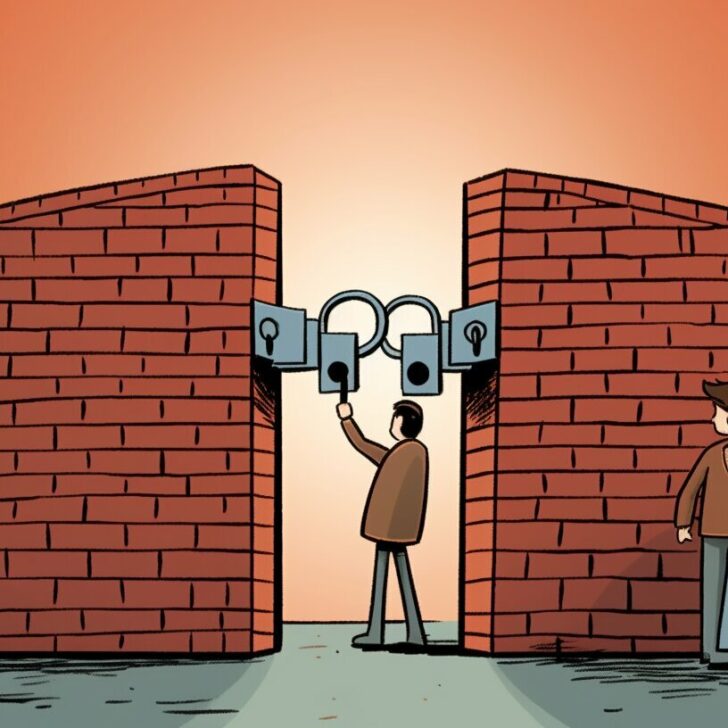What are the barriers to collaborative practice? Effective collaboration is essential for achieving success in any team or organization. However, there are a number of barriers to collaborative practice that can hinder your ability to work together effectively.
These barriers can range from resistance to change to poor communication skills and lack of dedicated resources.
In this article, we will explore these common obstacles for collaborative leaders and provide strategies for overcoming them.
Key Takeaways:
- As compared to directive leadership, Collaborative practice involves working together effectively as a team or organization
- Barriers to collaborative practice can include resistance to change, poor communication skills, and lack of dedicated resources
- Overcoming these collaborative practice barriers requires a commitment to teamwork and the implementation of effective strategies and solutions
Fear of Change: A Barrier to Collaborative Practice
What are the barriers to collaborative practice? Collaborative practice can be hindered by various barriers, one of which is the fear of change. When new ideas or processes are introduced, team members may resist because of uncertainties or concerns about their role.
To overcome this barrier, it’s important to understand that change is inevitable and necessary for growth and progress. Encourage open communication and transparency from the beginning, clearly outlining the goals and benefits of the proposed changes. This will help to alleviate fears and build trust within the team.
It’s also helpful to involve the team in the change process, asking for feedback and suggestions to help shape the implementation. This creates a sense of ownership and shared responsibility, reducing resistance.
Remember that change takes time and patience. Be prepared to listen to concerns and address them as they arise. Provide ongoing support and training to ensure team members feel comfortable with the new processes, and celebrate small successes along the way to maintain momentum.
By embracing change and working together to overcome the fear of it, your team can break down barriers to collaborative practice and achieve greater success.
Poor Communication Skills: Another Barrier to Collaborative Practice
Effective communication is critical to the success of any collaborative effort. Poor communication skills is one of the challenges in collaborative practice. It can lead to misunderstandings, delays, and mistakes that can compromise the quality of the final product.
As such, it is essential that team members possess strong communication skills to ensure that everyone is on the same page and that all ideas are effectively conveyed.
When communication skills are lacking, it can cause a range of problems. Some common collaborative practice issues include:
- Misunderstandings
- Missed deadlines
- Conflicts between team members
- Difficulty reaching a consensus
- Unproductive meetings
To improve communication skills, team members should focus on active listening and clear, concise speaking. Active listening involves paying attention to what the speaker is saying and asking clarifying questions to ensure that you fully understand their message.
Clear and concise speaking involves using simple language and avoiding jargon or technical terms that may confuse others.
Here are a few tips for improving communication within a collaborative team:
- Establish clear communication protocols from the start of the project
- Encourage all team members to participate in discussions
- Use visual aids, such as diagrams or charts, to clarify complex ideas
- Provide regular feedback to team members
- Be open to constructive criticism and use it to improve your communication skills
By prioritizing communication skills and proactively addressing poor communication, you can overcome this common barrier to effective collaboration and help your team achieve its goals.
Lack of Dedicated Resources: A Barrier to Collaboration
One major obstacle to collaborative practice is the lack of dedicated resources or even no dedicated resources! Without adequate resources such as time, money, and technology, it can be challenging to carry out collaborative projects effectively.
When team members do not have the proper tools or support, it can impede their ability to work together and achieve their goals.
Examples of a lack of dedicated resources include:
- Insufficient funding for project needs
- Inadequate training or education for team members
- Limited access to necessary technology or tools
- Inability to allocate enough time for collaboration due to other job demands
Eventually, not having dedicated resources can lead to frustration and burnout among team members.
Poor Work Life Balance
Another one of the barriers to effective collaboration is poor work life balance. Work life balance is commonly understood as the equilibrium or even a cycle between the time devoted to work tasks and the time spent on personal activities or with family.
If employees are constantly forced to work on collaborative projects outside of their primary responsibilities or during their personal time, it can cause resentment and disengagement.
With regards to work-life balance research compiled from a number of sources shows that there are 5 ways of improving collaboration in practice:
- Pause and evaluate
- Assess your priorities
- Time management
- Establish boundaries
- Reflect, refine, repeat
Overcoming Barriers to Collaborative Practice: Strategies and Solutions
Collaborative practice is essential for the success of any team or organization. However, there are many collaborative practice obstacles that can hinder effective collaboration.
Fortunately, there are also many strategies and solutions to overcome these barriers and improve teamwork.
Here are some strategies for overcoming collaboration barriers in practice:
1. Focus on Team Dynamics
Team dynamics are crucial for effective collaboration and removing approval paralysis. It’s important to create a supportive and inclusive environment where team members feel comfortable sharing ideas and opinions.
You can achieve this by setting clear expectations, establishing trust, and encouraging open communication. When team members feel heard and valued, they are more likely to contribute and work together towards a common goal.
2. Foster Innovation
Collaboration is an opportunity for innovation and creativity. To encourage innovation, you need to create an environment where team members feel comfortable taking risks and trying new things. This means giving them the freedom to experiment, providing resources and support, and celebrating their successes.
Remember that failure is also a part of the innovation process, and it’s essential for growth and learning.
3. Manage Common Obstacles
Endless “alignment” meetings and scope creep are common obstacles that can hinder collaboration.
To manage these, you need to establish clear goals and objectives for every project. This means setting boundaries and priorities, defining roles and responsibilities, and establishing clear communication protocols.
You can also use technology to streamline collaboration, such as project management tools and video conferencing software.
4. Provide Training and Support
Poor communication and old ways of thinking can be significant barriers to collaboration. To overcome these, you need to provide training and support to your team members. This might include workshops on effective communication, team-building exercises, and training on specific tools or software.
You can also provide ongoing coaching and support to help your team members develop the skills they need to succeed.
5. Celebrate Success
Celebrating success is a crucial part of collaboration. It helps to build morale, foster a sense of achievement, and strengthen team cohesion. Make sure you recognize and acknowledge the contributions of every team member, no matter how small.
This can be as simple as saying thank you, hosting a team event, or providing a reward or incentive.
Collaboration is essential for the success of any team or organization, but it’s not always easy.
By focusing on team dynamics, fostering innovation, managing common obstacles, providing training and support, and celebrating success, you can overcome barriers to collaboration and improve teamwork.
Conclusion
In today’s fast-paced and interconnected world, effective collaboration is essential for the success of any team or organization. However, there are various barriers to collaborative practice that can hinder teamwork and innovation.
By addressing these barriers, collaborative leaders can improve a team’s performance and foster a culture of effective collaboration. Some common barriers include a fear of change, poor communication skills, and a lack of dedicated resources.
To overcome these obstacles, it is important to develop strategies and solutions that work for your team. This could involve improving communication skills, fostering a culture of innovation, or dedicating more resources to collaborative projects.
The bottom line is that effective collaboration requires a commitment to teamwork and a willingness to overcome obstacles.
So, take the time to identify the barriers to collaboration in your team and start implementing solutions today. Remember, the success of your team depends on it!
FAQ For What Are The Barriers To Collaborative Practice?
Q: What are the barriers to collaborative practice?
A: The barriers to collaborative practice can include fear of change, poor communication skills, lack of dedicated resources, and other challenges that hinder effective collaboration within a team or organization.
Q: How does fear of change impede collaborative practice?
A: Fear of change can impede collaborative practice by creating resistance to new ideas or processes. Overcoming this barrier requires strategies to address and alleviate the fear, such as effective change management and communication.
Q: What impact do poor communication skills have on collaborative practice?
A: Poor communication skills can significantly hinder collaborative practice. Effective communication, both speaking and listening, is essential for successful teamwork. Improving communication skills within a team can enhance collaboration.
Q: How does a lack of dedicated resources act as a barrier to collaboration?
A: Not having dedicated resources for collaborative projects creates challenges and obstacles. Overcoming this barrier may involve finding creative solutions, securing necessary resources, or reallocating existing resources to support collaboration.
Q: What strategies and solutions can be used to overcome barriers to collaborative practice?
A: There are various strategies and solutions for overcoming barriers to collaborative practice. These may include fostering teamwork and innovation, managing common obstacles like endless meetings and scope creep, and promoting effective team dynamics.

